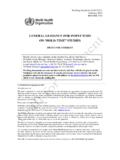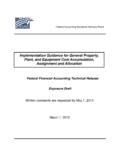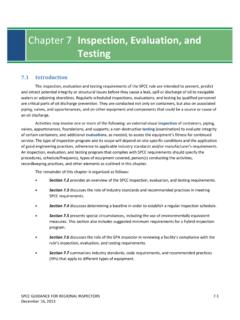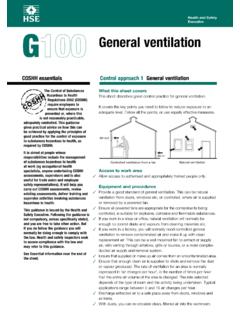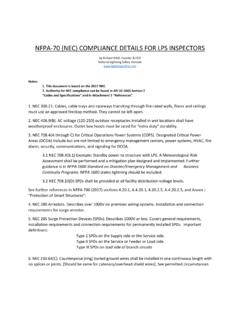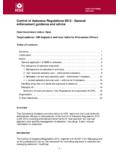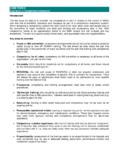Transcription of ON “HOLD-TIME” STUDIES - World Health Organization
1 Working document February 2014 Document for comment 1 2 3 4 GENERAL GUIDANCE 5 ON hold - time STUDIES 6 7 REVISED DRAFT FOR COMMENT 8 (February 2014) 9 10 11 12 13 14 15 16 17 18 19 20 21 _____ 22 World Health Organization 2014 23 All rights reserved. 24 This draft is intended for a restricted audience only, the individuals and organizations having received this draft. The 25 draft may not be reviewed, abstracted, quoted, reproduced, transmitted, distributed, translated or adapted, in part or in 26 whole, in any form or by any means outside these individuals and organizations (including the organizations' concerned 27 staff and member organizations) without the permission of the World Health Organization . The draft should not be 28 displayed on any website. 29 Please send any request for permission to: 30 Dr Deus Mubangizi, Group Leader, Prequalification Team Inspections, Regulation of Medicines and other Health 31 Technologies, Department of Essential Medicines and Health Products, World Health Organization , CH-1211 Geneva 32 27, Switzerland; e-mail: 33 The designations employed and the presentation of the material in this draft do not imply the expression of any opinion 34 whatsoever on the part of the World Health Organization concerning the legal status of any country, territory, city or 35 area or of its authorities, or concerning the delimitation of its frontiers or boundaries.
2 Dotted lines on maps represent 36 approximate border lines for which there may not yet be full agreement. 37 The mention of specific companies or of certain manufacturers products does not imply that they are endorsed or 38 recommended by the World Health Organization in preference to others of a similar nature that are not mentioned. 39 Errors and omissions excepted, the names of proprietary products are distinguished by initial capital letters. 40 All reasonable precautions have been taken by the World Health Organization to verify the information contained in 41 this draft. However, the printed material is being distributed without warranty of any kind, either expressed or implied. 42 The responsibility for the interpretation and use of the material lies with the reader. In no event shall the World Health 43 Organization be liable for damages arising from its use.
3 44 This draft does not necessarily represent the decisions or the stated policy of the World Health Organization . 45 46 Should you have any comments on the attached text, please send these to Dr Sabine Kopp, Group Lead, Medicines Quality Assurance, Technologies, Standards and Norms, World Health Organization , 1211 Geneva 27, Switzerland; email: fax: (+41 22) 791 4730 and to Ms Marie Gaspard by 15 April 2014. Working documents are sent out electronically and they will also be placed on the Medicines web site for comment. If you do not already receive directly our draft guidelines please let us have your e-mail address (to and we will add it to our electronic mailing list. Working document page 2 SCHEDULE FOR THE ADOPTION PROCESS OF DOCUMENT 47 GENERAL GUIDANCE FOR INSPECTORS ON hold - time STUDIES 48 49 Date Preparation of draft by Dr van Zyl, South Africa.)
4 Based on need identified by the WHO Prequalification Programme inspectors November-December 2012 Preliminary internal review of draft January 2013 Draft mailed for comments February 2013 Collation of comments April 2013 Review by inspectors collaborating with the WHO Prequalification Programme May 2013 Discussion during the joint informal consultation with Prequalification Inspection team and inspectors from national inspectorates 30 May 2013 Follow-up of e-Discussion of Subgroup with expert inspectors to finalize new draft of working document for comments June 2013 Recirculation of working document for comments July 2013 Compilation of comments and feedback September 2013 Review of feedback received with Prequalification Inspection team September 2013 Presentation to forty-eighth meeting of the WHO Expert Committee on Specifications for Pharmaceutical Preparations 14-18 October 2013 Review of comments with subgroup of WHO Expert Committee on Specifications for Pharmaceutical Preparations and subsequently with Dr van Zyl and the Prequalification Team Inspections Group October 2013 January 2014 Working document page 3 Further follow-up action as required.
5 Recirculation of working document for comments February 2014 Compilation of comments April 2014 Discussion of feedback during informal consultation on medicines quality: GXPs, inspection guides and risk management 28-30 April 2014 Recirculation of updated working document May 2014 Compilation of comments and evaluation of feedback received July 2014 Presentation to forty-ninth meeting of the WHO Expert Committee on Specifications for Pharmaceutical Preparations October 2014 Further follow-up action as required .. 50 51 Working document page 4 CONTENTS 52 53 1. Introduction and background 54 55 2. Scope 56 57 3. Aspects to be considered 58 59 1. INTRODUCTION AND BACKGROUND 60 61 Manufacturers should ensure that the products that they manufacture are safe, effective 62 and of the quality required for their intended use.
6 Products should be consistently 63 manufactured to the quality standards appropriate to their intended use and as required by 64 the marketing authorization. Systems should ensure that pharmaceutical products are 65 produced according to validated processes and to defined procedures. Manufacturing 66 processes should be shown to be capable of consistently manufacturing pharmaceutical 67 products of the required quality that comply with their specifications. 68 69 Arrangements should exist to ensure that the dispensed raw materials and packaging 70 materials, intermediate products, bulk and finished products are stored under appropriate 71 conditions. Storage should not have any significant negative effect on the processing, 72 stability, safety, efficacy or quality of the materials, intermediate products and bulk 73 products prior to final packing.
7 Good manufacturing practices (GMP) require that a 74 maximum acceptable holding period should be established to ensure that intermediates 75 and bulk product can be held, pending the next processing step, without any significant 76 adverse effect to the quality of the material. Such a holding period should be underwritten 77 by data, but need not be extended to find the edge of failure for holding 78 79 80 81 Working document page 5 2. SCOPE 82 83 This guideline focus primarily on aspects that should be considered in the design of the 84 hold - time STUDIES during the manufacture of solid dosage forms. Many of the principles 85 herein also apply to other dosage forms such as liquids, creams and ointments. This 86 guideline does not cover aspects for hold times in cleaning validation or the 87 manufacturing of active pharmaceutical ingredients (APIs).
8 88 89 This guideline is intended as a basic guide for use by pharmaceutical manufacturers and 90 GMP inspectors. This document does not intend to prescribe a process for establishing 91 hold times, but reflects aspects that should be considered in the design of the hold - time 92 study. 93 94 Manufacturers should gather scientific and justifiable data to demonstrate that the 95 dispensed raw materials and packaging materials, intermediate and bulk products: 96 97 - remain of appropriate quality before processing to the next stage; 98 - meet the acceptance criteria and release specification for the finished product. 99 100 3. ASPECTS TO BE CONSIDERED 101 102 hold time can be considered as the established time period for which materials 103 (dispensed raw materials, intermediates, bulk, and finished products under quarantine) 104 may be held under specified conditions and will remain within the defined specifications.
9 105 106 The quality and stability of dispensed raw materials, intermediate products, bulk (and 107 finished products in quarantine) should be ensured at all stages of manufacture. 108 109 Working document page 6 Data to justify the hold time can be collected during development on pilot-scale batches, 110 during process validation, or as part of an investigation of a deviation that occurred 111 during manufacture. 112 113 hold - time STUDIES establish the time limits for holding the materials at different stages of 114 production to ensure that the quality of the product does not deteriorate significantly 115 during the hold time . To validate the hold time under the specified hold - time condition, 116 results obtained should be within the limits of acceptance criteria throughout the hold 117 time .
10 hold times should normally be determined prior to marketing of a product and 118 following any significant changes in processes, equipment, starting and packaging 119 materials. However, for products already marketed retrospective risk-based, hold - time 120 STUDIES should be performed. 121 122 Manufacturers can consider following a most probable approach opposed to a worst-123 case approach , For example, in a worst case situation where a product has a maximum 124 hold time of seven days as granulate, 30 days as uncoated tablets, and six months as 125 coated bulk tablets, will probably not represent any actual batch that is intended for 126 commercial sale. A most probable approach would reflect actual hold times at each 127 stage, and apply the worst actual case, spreading the total hold time over the different 128 stages.










